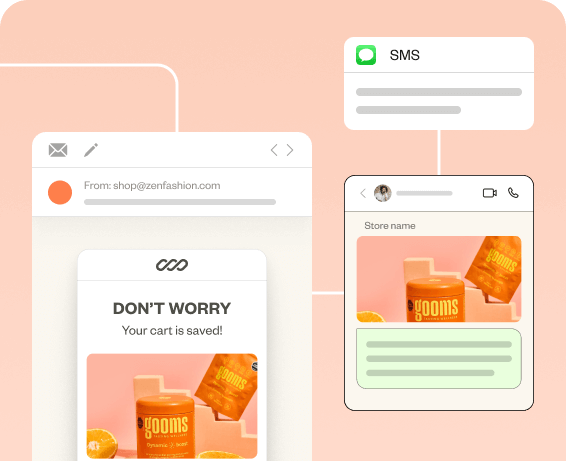Nearly 99% of your customers check emails almost every day. Hence, all you have to do is stand out from your competitors with smart ecommerce email marketing without high ad budgets or worrying about algorithm changes.
Ultimately, you can increase average order value through personalized ecommerce email campaigns, recover lost sales automatically, and turn occasional shoppers into loyal advocates.
This comprehensive guide educates you about high-converting templates, real campaign examples, proven strategies that worked for brands in 2025, best practices you can follow to stand out, and the best email marketing software to use for automating your efforts.
Automate your ecommerce emails in under 2 minutes with Retainful’s easy-to-setup email automation.
What is Ecommerce Email Marketing?
Ecommerce email marketing is the practice of sending targeted marketing emails to customers to promote products, drive repeat sales, and build customer loyalty.
Among all other marketing channels, email marketing boasts a high return on investment, giving you $36 dollars in return for every dollar spent. This is what makes an ecommerce email marketing unparalleled.
The reasons to use email marketing for ecommerce are:
- High customer retention rate
- High ROI
- Can be tailored content based on user behavior and preferences
- High customer engagement rate
7 Ecommerce Email Campaigns (Templates & Tips)
Ecommerce email marketing campaigns should be strategically sent based on a customer’s position in the email marketing funnel to ensure that the content is relevant and timely.
Early-stage customers should receive educational email newsletters about your products, while those further down the funnel get targeted promotions or exclusive offers.
Email marketing automation for e-commerce allows you to send email campaigns automatically based on customer behavior and their position in the email marketing funnel.
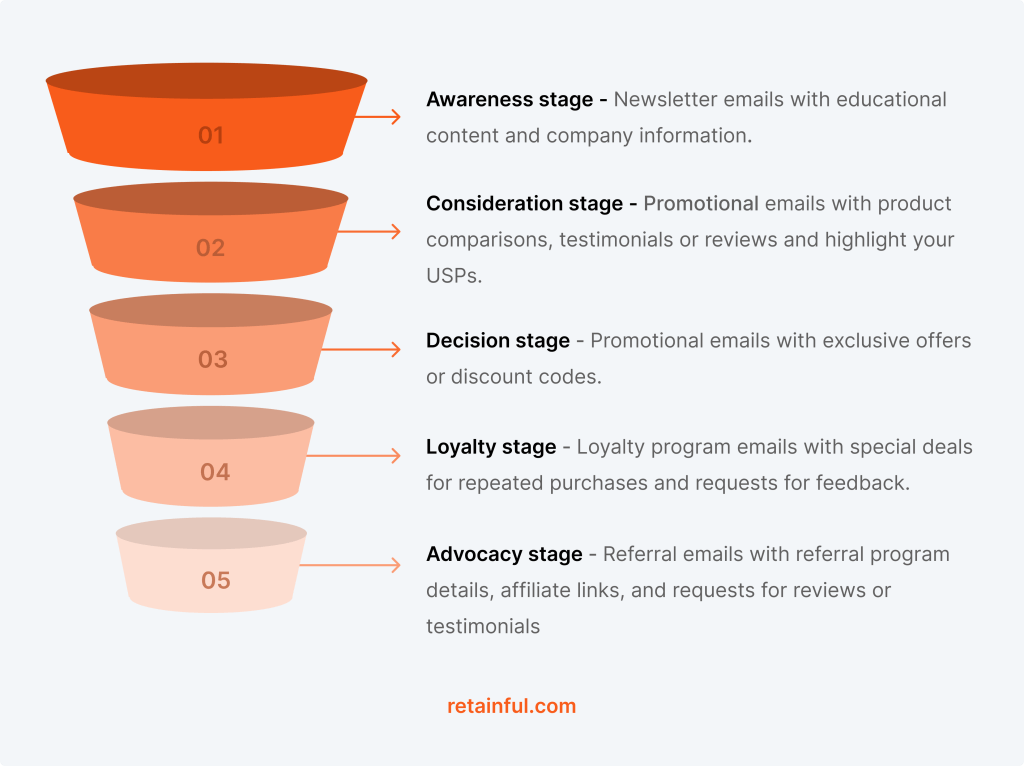
Here are the types of email marketing campaigns for ecommerce you can send:
- Welcome Email Series
- Email newsletters
- Abandoned cart emails
- Transactional emails
- Sales announcements and promotions
- Back in stock / out of stock messages for ecommerce
- Win-back emails
Let’s see these types of email marketing campaigns for ecommerce in detail.
1. Welcome Email Series
Welcome emails for new ecommerce customers generate 320% more revenue per email than other promotional emails. That’s why welcome emails are one of the most important ones you can send in email marketing for ecommerce.
When to send: Immediately after a customer subscribes or creates an account.
What to include in your ecommerce welcome email campaign:
- A warm greeting and thank you message
- A brief introduction to your brand and values
- Overview of what to expect from future emails
- Special offer or discount for new subscribers
Here is an ecommerce email marketing campaign example by Glossier.
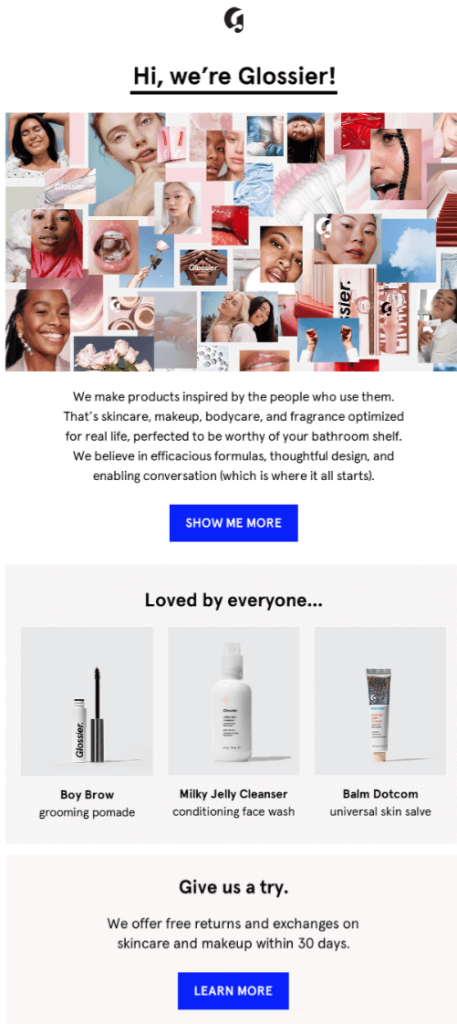
Related Reading: Explore more welcome email templates in our blog: 10 Best Welcome Email Examples + Steps to Write
2. Email Newsletters
Use email newsletters to share valuable content like product guides, how-tos, and industry insights. Additionally, product recommendation emails based on purchase history can be seamlessly integrated into newsletters as well.
While promotional emails are for hard-sell, ecommerce email newsletters are for soft-sell where you provide value to the reader beyond just selling.
When to send: Send email newsletters 2-3 days after welcome email.
What to include in your ecommerce email newsletter campaign:
- Product highlights include new product launches and your bestsellers.
- How-to guides related to your products
- Tips and tricks for using your products
- Case studies of how customers use your products
- Customer testimonials
Here is an ecommerce email example of newsletters:
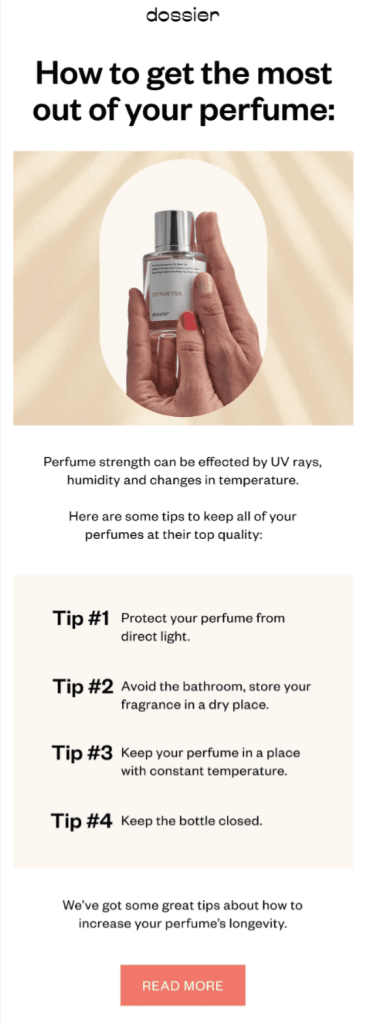
Related Reading: Learn more about sending email newsletters in our blogs:
How to send WooCommerce Newsletters (+ Plugins)
How to send Shopify email newsletters? – A Complete Guide
3. Abandoned Cart Emails
While most of your revenue is locked in abandoned carts, these cart recovery emails for ecommerce are your best bet to recover lost revenue. Furthermore, abandoned cart email best practices show that these emails are crucial for revenue recovery.
When to send: An hour after a customer leaves items in their cart without completing the purchase.
What to include in your ecommerce abandoned cart email campaign:
- A reminder of the items left in the cart
- Product images and descriptions
- Total cost and discounts
- Clear call-to-action (CTA) to complete the purchase
Here is an abandoned cart email template.
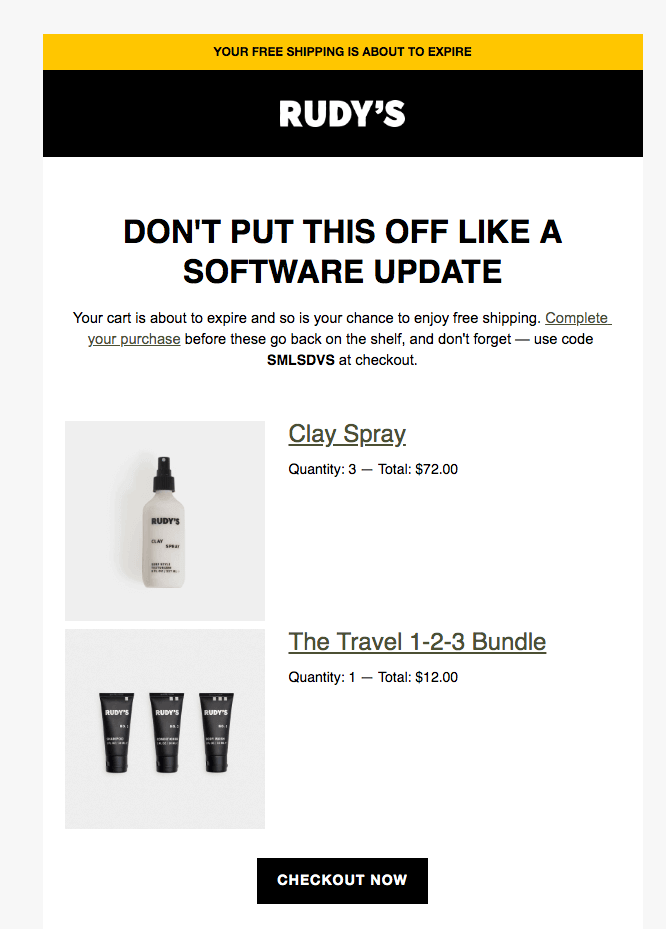
Related Reading: Learn more about sending abandoned cart emails:
Shopify Abandoned Cart Email – Strategies and Templates to Recover Lost Sales
How to Send WooCommerce Abandoned Cart Emails? A Step-by-Step Guide
4. Transactional emails
Beyond serving as mere notifications, post-purchase follow-up or transactional emails like order confirmation emails are important to enhance the customer experience, build trust/loyalty, and create opportunities for further engagement and sales.
When to send: Send automatically right after the purchase is completed
What to include in your ecommerce transactional email campaign :
- Thank You Message
- Order Details
- Payment Information
- Billing address
- Shipping Information
- Link to track the package
- Return and Exchange Policy
Here is an ecommerce order-follow-up email template by Crocs.
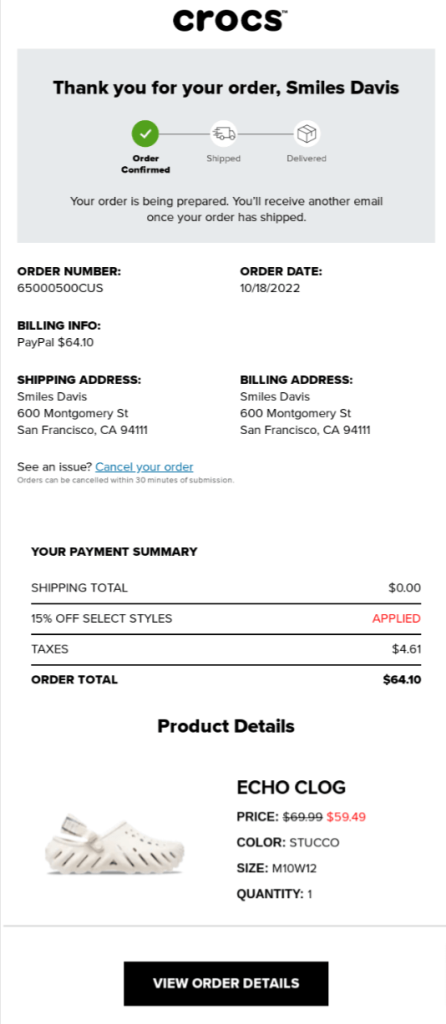
Related Reading: Explore more transactional email templates and get more design ideas:
How to send Shopify transactional emails?
How to Send WooCommerce Order Confirmation Emails? – A Step-by-Step Guide
5. Sale Announcements and Promotions
By sending sale announcements, discount emails and promotional ecommerce emails, you appeal to bargain hunters and deal-seekers, encourage first-time buyers to make initial purchases, and reactivate dormant customers with offers.
Additionally, you can send price drop emails or seasonal campaign emails for Q4 retail sales to not only drive conversions, but also to sell out leftover inventory.
When to send: During major shopping seasons, holidays, or when launching a new sale.
What to include in your ecommerce promotional email campaign:
- Clear details on discount amounts or promotional offers
- Sale duration and any terms/conditions
- Featured products or categories
- Sense of urgency (e.g., “Limited time offer”)
Here is an ecommerce email marketing template by Canon.
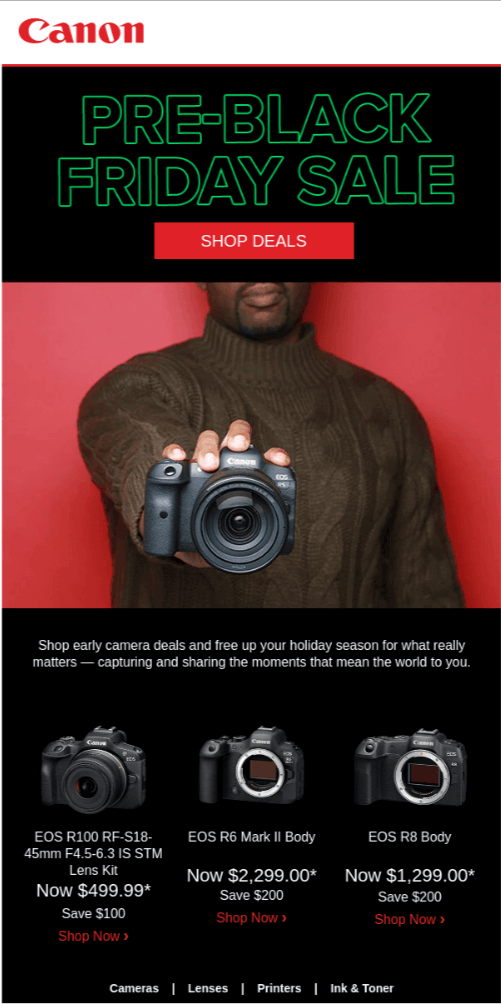
6. Back-in-stock emails
By sending back-in-stock emails, you can use ecommerce email marketing to convert potential lost sales into actual revenue and re-engage customers who showed interest but couldn’t purchase due to stockouts.
When to send: As soon as the item is restocked
What to include in your back-in-stock email campaign:
- Product Details: Name of the restocked item, high-quality product image, price
- Sense of Urgency: Mention limited quantities if applicable. Example: “Only 10 items back in stock!”
- Suggest related or alternative products
Here is a back-in-stock / out-of-stock message for an ecommerce example.
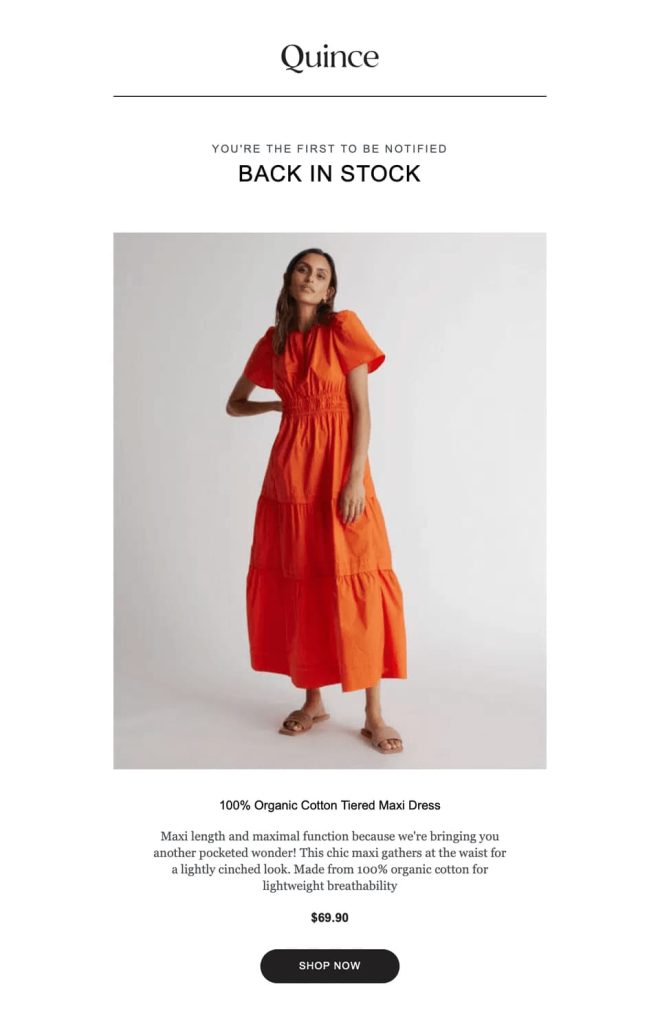
7. Win-back emails
Not every customer sticks with you forever. Some drift off. But they are not a lost cause yet. Not when you present them enough reasons to come back through a re-engagement email or win-back email.
When to send: After a period of 45 to 60 days of inactivity.
What to include in your ecommerce win-back email campaign:
- Acknowledgment of absence
- Highlight what makes your brand/products unique
- Showcase any new products or features they might have missed
- Incentive to return
- Customer testimonials
- Update on What’s New
Here is an ecommerce email campaign example for a win-back email.
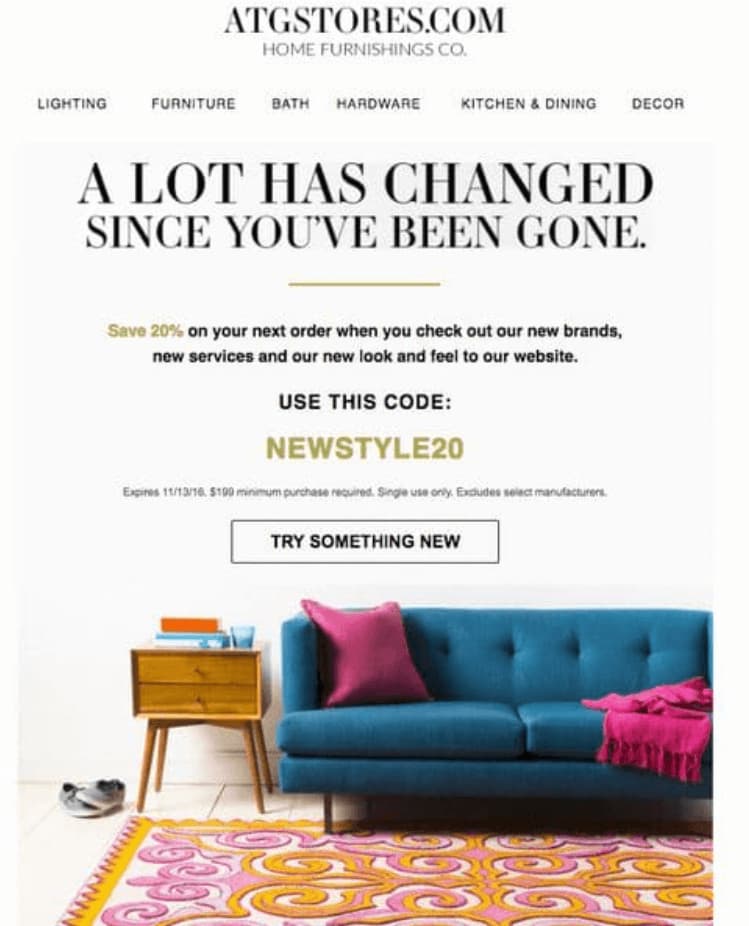
Customize your ecommerce emails with Retainful’s beginner-friendly drag-and-drop email editor.
8 Proven Ecommerce Email Marketing Strategies for 2025
In this section, we help you create an email marketing strategy to sell more through advanced email marketing for ecommerce.
The prerequisites to analyze before you build a winning ecommerce email marketing strategy:
- Define Your Email Goals for Measurable Growth
- Customer Segmentation for Higher Engagement and Conversions
- Map Email Campaigns Across the Customer Journey
- Automate and Schedule Emails to Save Time and Scale Easily
- Analyze Email Marketing Metrics to Improve Performance
Let’s look at the email marketing best practices for online stores’ strategies in detail.
1. Automate Ecommerce Emails to Drive Sales on Autopilot
Ecommerce email marketing automation allows you to deliver timely, personalized emails at each stage of the customer journey without manual effort. Automate product recommendations to enhance customer experience and boost sales.
Imagine your team not having to manually send welcome messages or follow-ups. Instead, these are handled automatically, saving hours of labor and reducing the chance of human error.
Ecommerce email marketing automation software offers automated workflows – the pre-defined sequences that combine triggers and actions. By sequencing these elements, you create a multi-step automated workflow for your customers.
Here is an example of an ecommerce email marketing automation workflow:
Abandoned cart recovery automation: Triggered when a customer abandons the cart and sends out a sequence of abandoned cart emails reminding customers at well-timed intervals.
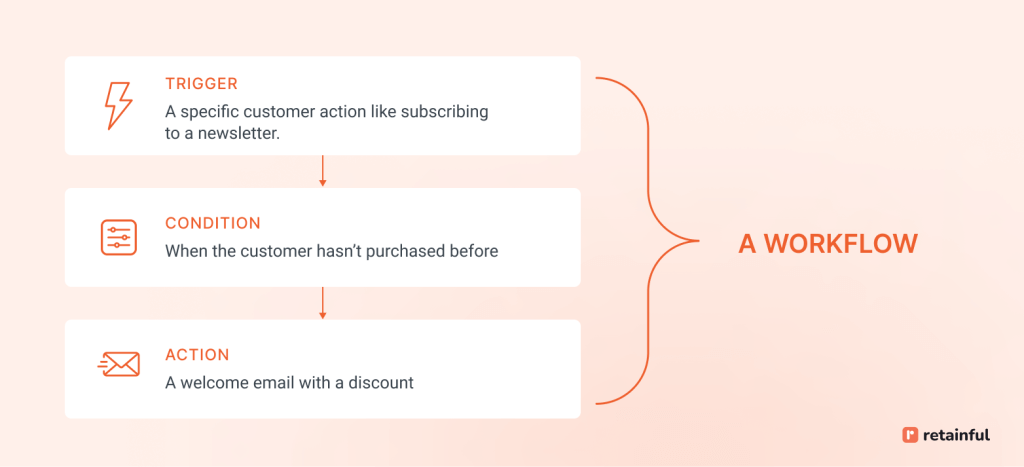
2. Use Email Segmentation for Higher Conversionstation
Email segmentation involves dividing your email list into groups based on criteria like age, location, or purchase history, and it allows you to implement personalized email marketing for ecommerce. Hence, target with dynamic and real-time email personalisation for maximum impact.
Email segmentation is the most high-converting ecommerce email marketing strategy out there.
Here is why:
- Segmented ecommerce email campaigns had 100.95% more clicks compared to non-segmented emails.
- Segmented ecommerce email campaigns result in a 760% increase in revenue.
There are five types of ecommerce email segmentation techniques:
- Demographic segmentation
Criteria: Age, gender, location, income, education level, occupation, etc. - Behavioral segmentation
Criteria: Purchase history, website activity, email engagement, shopping cart abandonment, etc. - Preference-based segmentation
Criteria: Product interest, content preferences, etc. - Lifecycle stage segmentation
Criteria: New customers, active customers, inactive customers, loyal customers, etc - Purchase history-based segmentation
Criteria: Frequency of purchases, Total purchase value, Product categories, Purchase history trends
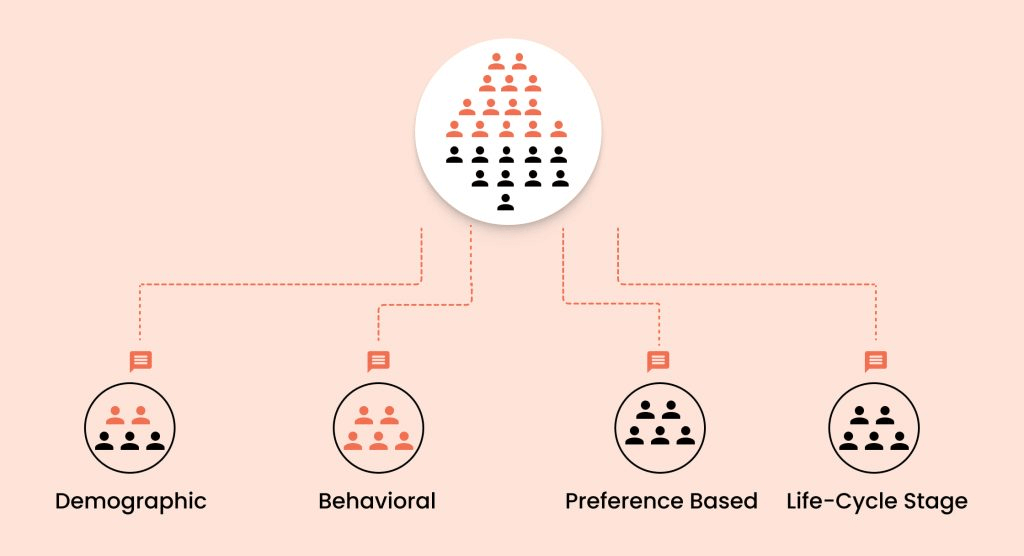
3. Personalize Emails for Strong Customer Relationships
Email personalization is more than just adding a recipient’s name to a subject line.
Personalization as an ecommerce email marketing strategy is about creating tailored experiences that resonate with each customer, making them feel valued and understood. Personalizing emails is the best customer retention strategies you can implement in ecommerce email marketing.

The ways to do personalized ecommerce email marketing are:
- Use customer names
- Segment your customers
- Recommend products based on browsing behavior
- Use purchase history data
- Send birthday and anniversary emails
- Implement behavioral triggers
- Include location-based content
By personalizing emails, you can reduce unsubscribe rates through email marketing in ecommerce.
4. Build Your Email List Organically for Quality Engagement
Building an email list organically is one of the most powerful assets for any ecommerce business.
The best email marketing strategy for ecommerce is to avoid buying email list. Unlike buying lists, organic list-building ensures you reach people who genuinely want to hear from you, resulting in higher engagement and better email deliverability. Grow your email list faster with smart sign-ups and convert browsers into subscribers effectively.
Here are the proven strategies to build an email list organically for ecommerce email marketing:
- Use targeted popups and newsletter signup-forms to capture email address.
- Give visitors a compelling reason to subscribe such as a discount, free shipping, or access to exclusive content.
- Offer valuable resources like e-books, checklists, or buying guides in exchange for email addresses.
Here is an example of newsletter signup form you can use in your ecommerce store:

Related Reading: Explore email list building tools for ecommerce and their detailed comparison:
The 11 Best Email List Building Tools To Increase Conversions
10 Best Shopify Popup Apps to Grow Your Email List
5. Optimize Email Deliverability to Reach the Inbox
High email deliverability ensures your ecommerce email marketing campaigns reach the inbox, not the spam folder. If they don’t land where they should, they’re as good as invisible. Compliance with email marketing laws (GDPR, CAN-SPAM) is essential for maintaining deliverability.
Ecommmerce email marketing tips to achieve high email deliverability are:
- Verify your sending domain
- Maintain a clean email subscriber list
- Sending personalized ecommerce emails
- Avoid spammy words
- Implement double opt-in
- Monitor your unsubscribe rates
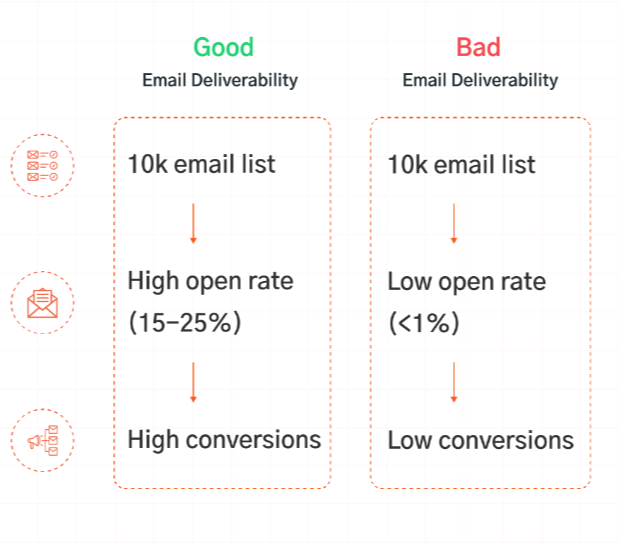
6. Avoid Overloading with Promotional Emails
Sending too many ecommerce promotional email campaigns can lead to unsubscribes and decreased engagement.
The best ecommerce email marketing strategy to reduce unsubscribe rates is to balance promotional content with value-driven emails like educational content or product tips.
7. Focus on CTR, Not Just Opens
Clicks are a direct path to conversions and a key ecommerce email marketing metric. The more clicks you get, the higher the chances of turning one-time buyers into repeat customers.
Ecommerce email marketing tips to achieve high CTR are:
- Segment your customers and personalize your email content based on the unique characteristics of each customer segment.
- Include clear Calls to Action (CTAs)
- Create mobile-optimized ecommerce email campaigns
- Use A/B testing for ecommerce email performance improvement
8. Include User-Generated Content for High Trust and Sales
The best ecommerce email marketing idea is to integrate social proof in ecommerce emails and build trust.
Feature customer reviews, testimonials, or photos in your ecommerce email campaigns.
9. Use Clear CTAs to Guide Towards Action
CTAs are the critical prompts that guide recipients toward taking the actions you want them to, such as making a purchase, signing up for a webinar, or downloading a resource in your ecommerce email marketing campaigns.
Here are some tips to include strong CTAs.
- Use strong, directive verbs such as “Shop Now,” “Get Started,” “Download,” or “Claim Your Offer”.
- Limit the CTA to a short, direct phrase. For example, instead of “Explore Our Extensive Range of Products,” use “Browse Our New Collection”.
- Use contrasting colors that stand out against the rest of your email design.
- Include phrases like “Limited Time Offer,” “Act Now,” or “Ends Today” in your CTA.
- Position CTAs above the fold and include them at the end of the email.
Email Marketing Best Practices for Online Stores
Ecommerce email marketing best practices are crucial because they ensure your messages actually get opened, read, and acted upon. Without them, you’re just spamming inboxes.
Here are the must-follow ecommerce email marketing best practices.
Prioritize CTR Over Opens to Maximize Sales Impact
An ecommerce email marketing best practice is to optimize your automated ecommerce email campaigns not only for open rates but for click-through rates, too.
While open rates measure how many recipients open your email, click-through rates indicate how effective your ecommerce email is at driving action. CTR as an ecommerce email marketing metric provides a clearer picture of engagement and the relevance of your content.
Balance Automation with Personalization for Human-Centered Emails
Generic email blasts are a thing of the past.
Even though automated emails for ecommerce sound like sending generic emails to everyone in the email list, you can segment the customers and send personalized emails through ecommerce email automation, too.
Cover the Full Customer Lifecycle to Drive Repeat Purchases the customer lifecycle.
The ecommerce email marketing best practice is to be consistent in sending emails throughout the customer lifecycle stages.
Implement ecommerce email marketing automation workflows that address each stage of the customer journey, such as welcome newsletters for new subscribers, educational content for nurturing, and re-engagement campaigns for inactive customers. Loyalty and rewards program emails for ecommerce and increasing AOV with a first purchase program are essential components.
Doing lifecycle email marketing helps convert potential customers into buyers and loyal ones.
Maintain a Clean List With List Suppression Features
Build an ecommerce email marketing strategy that leads to a clean email list and improves deliverability and engagement by removing invalid, inactive, or duplicate addresses.
List suppression features of email marketing tools help prevent emails from being sent to users who have opted out or bounced previously.
Choose the Right Email Software to Scale With Your Store
Features and ease-of-use of email marketing software impact your success of ecommerce email marketing ideas. How to choose the best ecommerce email marketing software depends on your specific needs and integrating the ecommerce site and email platform capabilities.
Evaluate the best tools for ecommerce email marketing automation based on:
- Is the platform easy to use?
- Does it provide all major ecommerce automation workflows?
- How effective is abandoned cart recovery?
- How easy is it to customize email templates?
- Integrate the ecommerce site and email platform seamlessly
Implement A/B Testing for Performance Optimization
Use A/B testing for ecommerce email performance improvement to optimize your campaigns continuously. Split-testing wizard for Black Friday campaigns can be particularly valuable during peak sales periods.
A/B testing for ecommerce email performance improvement should focus on:
- Subject lines
- CTA buttons
- Email timing
- Content personalization
- Mobile-optimized ecommerce email campaign layouts
About 50% of users delete emails not optimized for mobile, making mobile-optimized ecommerce email campaigns essential for success.
5 Best Email Marketing Software for Ecommerce
The 5 best ecommerce email marketing software are:
- Retainful
- Omnisend
- Mailchimp
- Activecampaign
- Brevo
Let’s look at these tools in detail.
1. Retainful
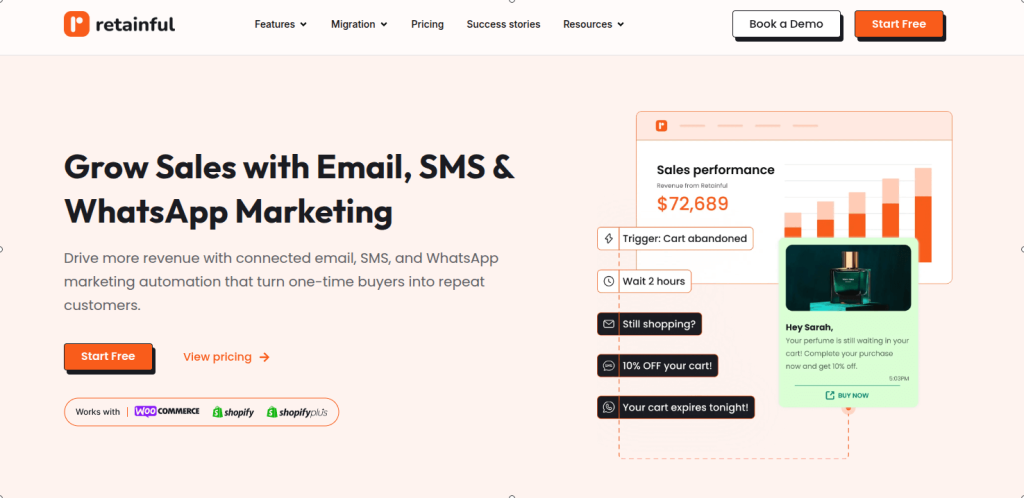
Retainful is the best ecommerce email marketing software that features easy-to-setup email automation. Every feature is tailor-made for ecommerce store owners like you.
It has seamless ecommerce email marketing automation at its core and is very simple to use – you wouldn’t need a 3-page manual to automate emails.
You can create targeted sign-up forms and popups that collect the email addresses of your visitors and help you grow your email list.
This ecommerce email marketing platform’s advanced segmentation feature allows you to group your customers based on many pre-defined or custom criteria and do personalized email marketing for ecommerce.
Coming to crafting your emails effortlessly, it has an intuitive drag-and-drop editor – no code required.
Standout features:
- Easy-to-setup email automation
- Pre-built automation workflows
- One-click abandoned cart recovery
- Pre-designed email segmentation templates
- Targeted sign-up forms
- Free plan: 500 Emails
- $14/month: 10,000 Emails
- $69/month: Unlimited Emails
2. Omnisend
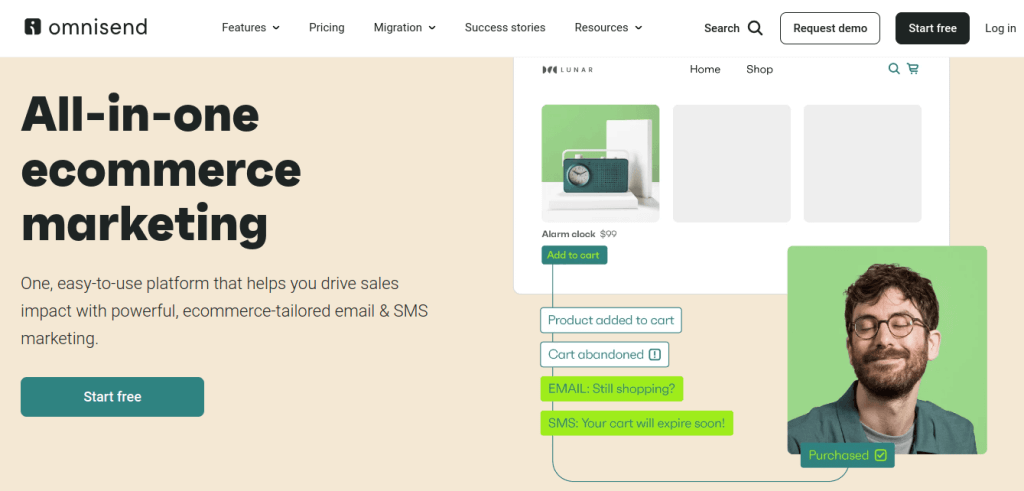
Omnisend is an omni-channel ecommerce marketing platform – that combines email, SMS, and push notifications.
It provides email marketing automation for ecommerce, allowing you to set up automation workflows for cart abandonment, browse abandonment, post-purchase emails, welcome emails, and more.
It allows you to include dynamic content using customer data and behavior, ensuring each recipient receives a tailored message.
This ecommerce email marketing tool offers various tools for email capture: targeted popups, landing page builders, sign-up forms, and exit-intent popups.
Standout Features:
- Enhanced customer journey mapping
- Dynamic content and advanced segmentation
- Comprehensive reporting and analytics
- Ecommerce focused features
Price tiers and Email Volume:
- Free plan
- Pro – $41.30/month
- Standard – $11.20/month
3. Mailchimp
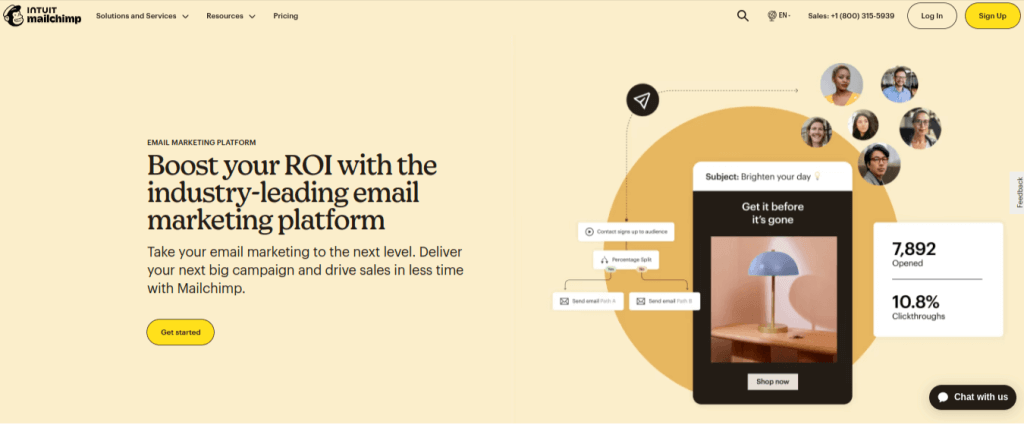
Mailchimp is a full-fledged digital marketing hub, giving you multichannel campaign support, website-building tools, reports, and ecommerce email marketing automation. It covers almost all of the bases a small business needs to get started.
This best email marketing software for ecommerce allows you to have a taste of almost all its key features with a free plan. You just have to sign up with your email to access the one-step email automation, the marketing CRM, multichannel marketing tools, and pre-designed email templates.
Standout Features:
- Enhanced automated customer journey
- AI suggestions for crafting emails
- Both pre-built and custom email templates
- Surveys and feedback creator
- Landing page builder
Price tiers and Email Volume:
- Free plan: 1000 emails
- Standard – $6.64/month: 6000 Emails
- Premium – $130.69/month: 150000 Emails
Related Reading: Explore more ecommerce email software that are best alternatives to MailChimp and Klaviyo:
8 Best Mailchimp Alternatives and Competitors in 2025
10 Best Klaviyo Alternatives & Competitors
4. ActiveCampaign
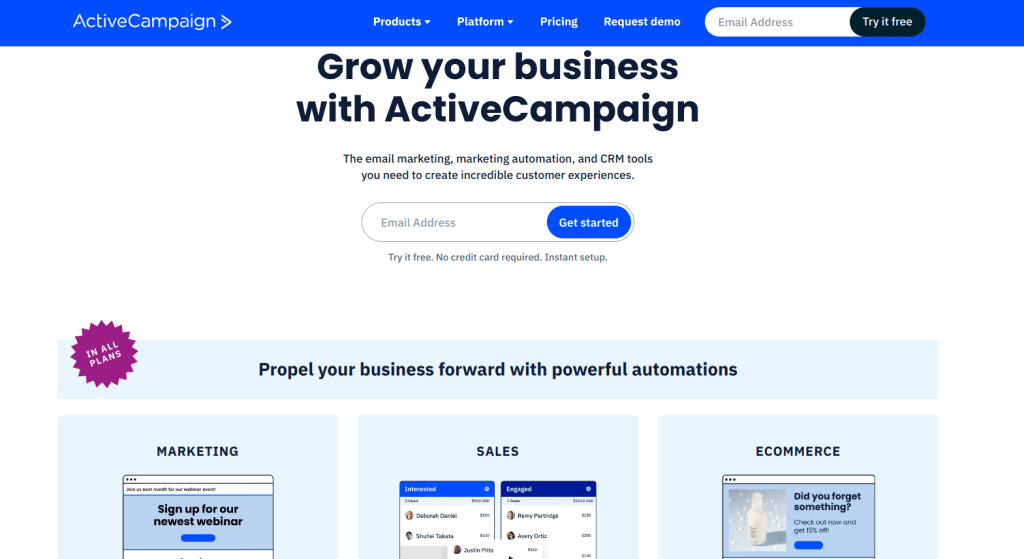
ActiveCampaign’s automation capabilities allow users to create complex, automated workflows that can trigger personalized emails based on specific actions, behaviors, or time intervals.
Beyond email marketing, this ecommerce email marketing tool offers a built-in CRM system designed to manage and nurture leads throughout the sales funnel.
This best ecommerce email marketing platform also enables site and event tracking, allowing users to monitor subscriber interactions with their website and other digital assets.
Standout Features:
- Predictive sending and content
- Dynamic content personalization
- Comprehensive CRM features
Pricing:
- Starter – $15 /month
- Plus – $49 /month
- Pro – $79 /month
- Enterprise – $145 /month
5. Brevo
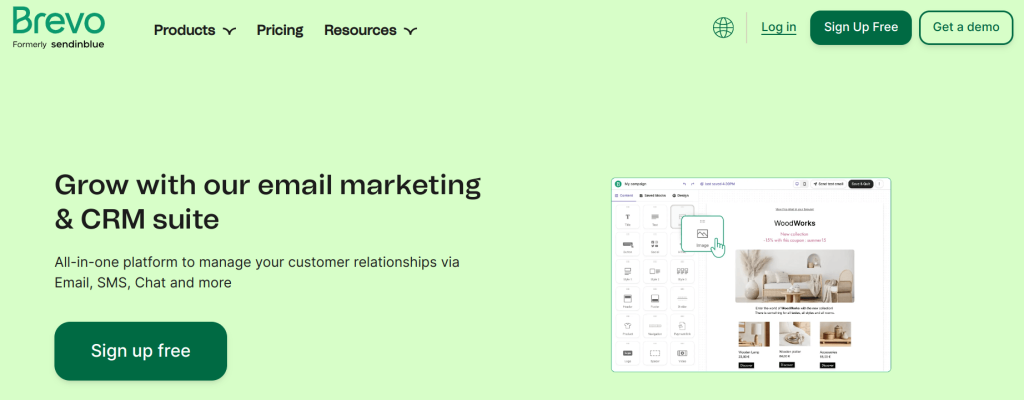
Brevo, formerly known as Sendinblue, is an ecommerce email marketing software and has evolved to become a comprehensive customer relationship management suite.
This best email marketing software for ecommerce offers a clean interface for creating automation workflows, with options to create your own or use one of the pre-built templates.
Using this email marketing tool, you can build and design custom landing pages to capture leads, promote offers, and drive conversions.
Standout Features:
- A/B Testing
- CRM integration
- Dynamic content blocks
- Landing page builder
Price tiers and email volume:
- Free plan: 300 emails/month
- Starter: $8/month
- Business: $16/month
Send personalized ecommerce emails and increase your conversion rate with Retainful’s email segmentation.
Wrapping up!!
To do ecommerce email marketing effectively, focus on what truly matters: relevance and timing. Craft emails that resonate with where your customers are in their journey, not just their inboxes.
Firstly, implement all the email marketing best practices for online stores to increase revenue without burning cash.
Secondly, building a winning ecommerce email marketing strategy requires focusing on mobile-optimized ecommerce email campaigns, A/B testing for ecommerce email performance improvement, and social proof integration in ecommerce emails.
Thirdly, use data to drive your decisions – optimize for click-through rates, not just open rates. Then, do personalized email marketing to make every interaction feel tailored and meaningful.
To automate all this and increase efficiency, choose the best ecommerce email marketing software that is cost-effective, meets all your needs, and allows you to integrate your ecommerce site and email platform seamlessly.
Read about platform-specific ecommerce email marketing:
- Shopify Email Marketing: A Guide to Create Email Marketing Campaigns
- WooCommerce Email Marketing: An Ultimate Beginner’s Guide
- 9 Best WordPress Email Marketing Plugins (+ Comparison Chart)
Frequently Asked Questions
Achieve results by segmenting your list, personalizing content, automating workflows, and analyzing performance metrics.
The best time to send eCommerce emails is typically mid-morning (around 10-11 AM) or early afternoon (1-3 PM).
The average email open rate for eCommerce emails ranges from 15% to 25%.
An effective email sequence includes a welcome email, cart abandonment follow-ups, post-purchase thank yous, and re-engagement campaigns.
Use email marketing effectively by personalizing content, automating responses, segmenting your audience, and testing different strategies.
Tuesdays and Thursdays are generally the best days for eCommerce emails, as they often see higher open and click-through rates.
Focus on building a quality email list, personalize content, use automation for efficiency, and engage with personalized content.
Key metrics include open rates, click-through rates (CTR), conversion rates, bounce rates, unsubscribe rates, and revenue per email.
